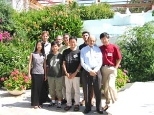If Shuguang Zhang has any say, tiny protein building blocks called peptides will launch the age of designed materials within the next decade.
Zhang, associate director of the Center for Biomedical Engineering and co-organizer of the first two world workshops on self-assembly of peptides and proteins in biology, medicine and engineering, is certain that the future of the emerging field of bionanotechnology lies in these tiny biological entities, which have the as-yet-mysterious ability to self-assemble.
While Zhang points out that self-assembly is ubiquitous in nature (for example, flocks of birds and schools of fish), much of the research presented at the multidisciplinary workshop in Crete in July revolved around just how these little molecules do what they do.
Given the right conditions--some salt and water--peptides that are structurally and chemically compatible come together like automated LEGOs.
Peptides form complex two- and three-dimensional structures ranging from DNA to the plaques that build up in the brains to Alzheimer's patients. As a new nanobiotechnological material such as benign biological three-dimensional scaffolding, peptides may soon replace the metals and plastics now used to grow living cells inside and outside the body.
Among other things, Zhang sees peptides as molecular cement--a generic material that can be used to fill holes almost anywhere it is needed, such as helping nerves regenerate a severed spinal cord.
APPLICATIONS GALORE
While scientists and engineers around the world continue to investigate just how self-assembly works and how to manipulate it, some are moving forward with a dizzying variety of applications.
"This workshop will be an incubator for the development of new technologies," the organizers wrote. "It is tremendously exciting to bring biologists, chemists, physicists and various engineers under one roof."
At the workshop, Associate Professor Joseph Jacobson of the Media Lab presented his work on controlling tiny biomolecular machines through radio frequency. Jacobson, whose background is in physics, became interested in using biology as a tool to create nanometer-length machines. The ultimate goal, he said, is a machine on the single-atom or single-molecule level.
It's hard to manufacture computer chips much smaller than 30 nanometers, but biology has an excellent track record at creating tiny workable systems. The cell itself is a phenomenal little machine with its own power supply and memory. "If we're interested in molecular-scale machines, biology is a wonderful place to start," Jacobson said. He's working on hybrid structures in which the machinery of biology can be programmed electronically.
It's not exactly "ET, phone home," but Jacobson would like to be able to "speak" to individual biomolecules. He'd like to tell them what to do in a variety of different applications, such as programming building blocks or coming together to make specific molecules.
To that end, he and his group (a collaboration of the Media Lab, the Center for Biomedical Engineering and the Department of Chemistry) attached tiny radio-frequency antennae--a nanocluster of 30 to 50 atoms of a metal or semiconductor--to a protein.
By transmitting a radio-frequency magnetic field into the little antennae, he zaps the molecule with energy. The heat makes the molecule act in a certain way. With this tool, researchers may be able to open or close a protein, make its domain active or inactive, or assemble or disassemble structures.
The goal is build molecules into systems that turn on and off depending on the electronic commands they receive. It may some day be possible to hook the antennae into living systems and turn genes on and off.
CREATING NEW MATERIALS
Roger D. Kamm, professor of mechanical engineering in the Division of Bioengineering and Environmental Health, explores the properties of three-dimensional protein networks that form filaments, in a collaboration that includes MIT biologists, physicists and mechanical engineers,
These amino acid series may be useful as scaffolds for tissue engineering, because some living cells grow on them happily, or as nanostructures for the study of protein formation.
"These peptide materials exhibit a wide variety of properties," Kamm said. "The question is, can we gain the knowledge to control their design?"
Kamm hopes that by investigating the mechanical properties of a new biomaterial that his group has created, he will be able to improve upon the material and others like it, and design new materials with even better properties.
AN ACCIDENT AND A PLAN
Zhang stumbled on self-assembling peptides by accident while studying left-handed DNA with Alexander Rich, the William Thompson Sedgwick Professor of Biophysics.
At the Crete workshop, Rich described how, with primitive imaging tools in the 1950s, he and colleagues found that the long molecules of RNA find their way into DNA's famous double helix conformation uncovered by Watson and Crick. "This established the foundation for continuing to the point where we can hear elegant presentations of how these systems can be built up to explain a large variety of chemical and biological phenomena," Rich said.
With Rich's blessing, Zhang diverged his DNA studies in 1991 to pursue peptides, and now oversees a cadre of talented doctoral students and postdoctoral fellows attempting to take understanding and application to the next level.
He organized the first worldwide conference on the biological, medical and engineering applications of peptides in Crete in 1999. This year, Zhang again brought together more than 100 researchers pursuing ever-more-ambitious uses and knowledge. In addition to Kamm, Jacobson, Zhang and Rich, MIT participants were Kimberly Hamad, a postdoctoral associate in the Media Lab; Davide Marini and Nikola Kojic, graduate students in mechanical engineering; Carlos Semino, a research scientist in the Center for Biomedical Engineering (CBE); Wonmuk Hwang, a postdoctoral associate in CBE; and Pei-Hsin Lin, a senior in biology and in electrical engineering and computer science (see related story on this page).
Zhang pointed out that without the DNA-RNA hybridization groundwork carried out by Rich in 1956, the revolution that led to innovations such as gene chips would not be possible. He's confident that peptides will lead to no less of a scientific revolution.
A version of this article appeared in MIT Tech Talk on September 12, 2001.






